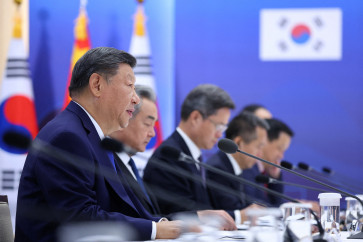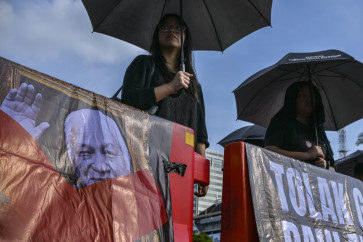Popular Reads
Top Results
Can't find what you're looking for?
View all search resultsPopular Reads
Top Results
Can't find what you're looking for?
View all search resultsAncient masks on display at Jogja Museum
Nearly 500 ancient masks from various regions across Indonesia are being displayed as part of ââThe Power Of Topengââ exhibition, held from Nov
Change text size
Gift Premium Articles
to Anyone
N
early 500 ancient masks from various regions across Indonesia are being displayed as part of ''The Power Of Topeng'' exhibition, held from Nov. 20 to 29 at Sonobudoyo Museum in Yogyakarta. The topeng (masks) are expected to serve as an entry point for visitors to observe the local culture of a respective region.
A curator for the exhibition, I Wayan Dana, explained that at least 400 of the displayed topeng were special masks sourced from different regions throughout the archipelago, while at least 90 others were part of the private collection of the Sonobudoyo Museum.
Dana said that historically, apart from being works of arts, topeng were also a major part of religious rituals.
'Both functions are mutually strengthening. Topeng are rooted in society and are a significant part of culture in Indonesia,' Dana said at the opening ceremony of the exhibition on Thursday evening.
In religious rituals, topeng, according to Dana, were originally used to pull and to communicate with spirits and supernatural powers. They were later preserved and modified in line with the development of the traditions and rituals of every age.
In Indonesia, Dana said, topeng developed side by side with the development of ancient kingdoms in Indonesia.
In his book 'Prehistoric Life of Indonesia', published in 1955, Duth archaelogist Hendrik Robert van Heekeren estimated that topeng had been part of the country's prehistoric history.
The Panji masks, for instance, were developed during the era of Majapahit kingdom and are used to teach a series of love stories.
The Ramayana masks, on the other hand, were developed during the era of the Hindu kingdoms in Indonesia, while the Ngayogyakarta Palace masks were developed during the leadership of Sultan Hamengkubuwono VII. There are also Cirebonan masks and many others.
Yogyakarta Culture Agency head Umar Priyono expressed hope that the exhibition would help share an insight into the development of topeng both as works of art and as instruments in religious rituals.
The exhibition, he said, was also aimed at introducing the historical and cultural value of topeng to the general public. This, he said, would later help develop topeng handicraft businesses across the country.
'Our commitment is that our traditional arts should be able to reach an new aspect of economic stability, to enable our traditional skills to again be useful for the people's economy,' Umar said.
Some of the oldest topeng on display, according to Umar, were made in the 1920s. He went on to say that several of the topeng on dispay for the exhibition had rarely been shown in the public due to their priceless value.
'There is an old topeng from the Ngayogyakarta Hadiningrat Palace that was made during the era of Sultan Hamengkubuwono VII. This topeng has a very high historical value, so much so that it cannot just be exhibited at any time,' he said.
Another curator, Ons Untoro, said that topeng could also become a tool to examine local culture and tradition.
'Every type of topeng has a unique style and distinctive pattern as each have been influenced by particular traditions that have been shaped over a long period of time,' Ons said.










